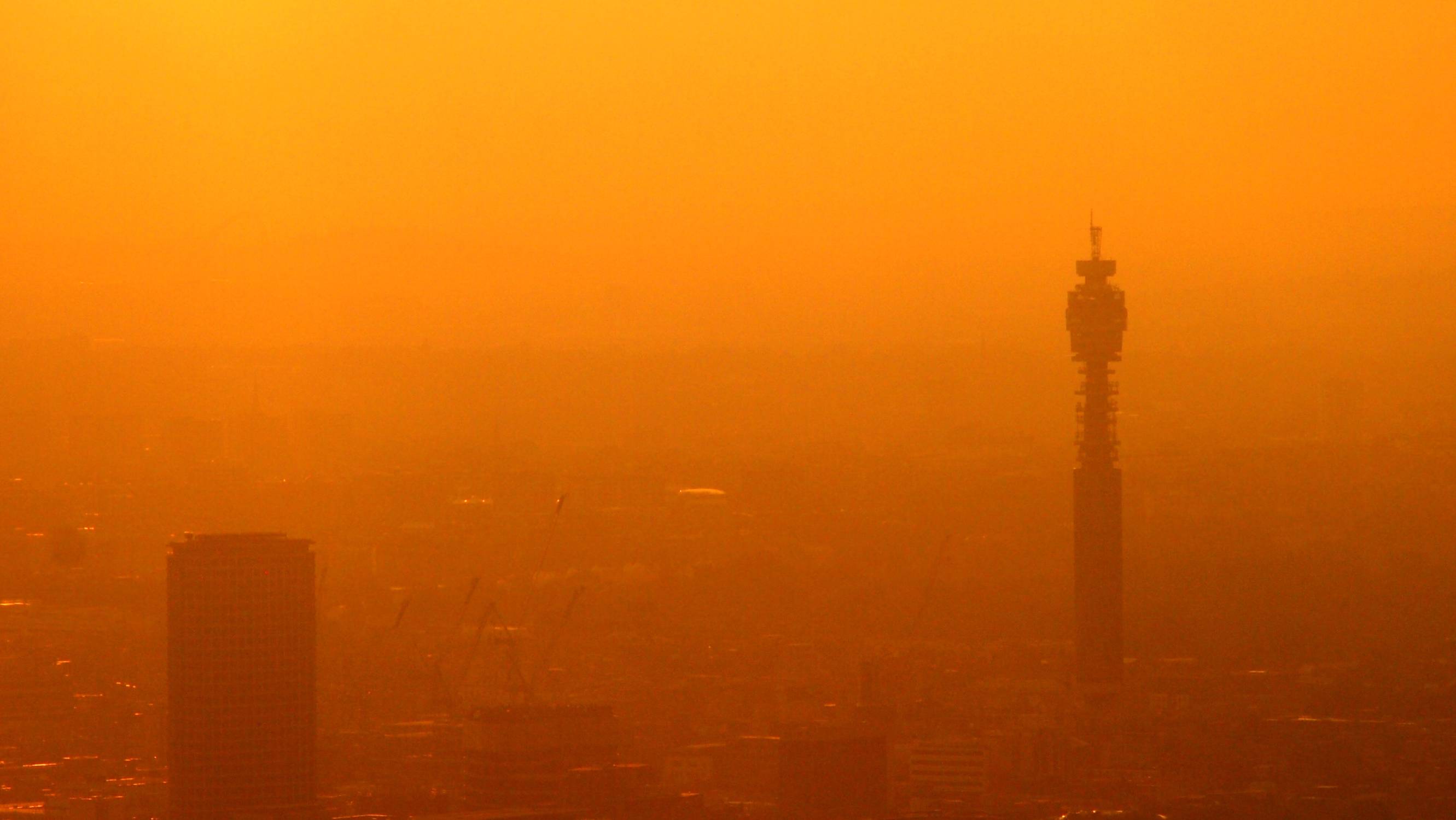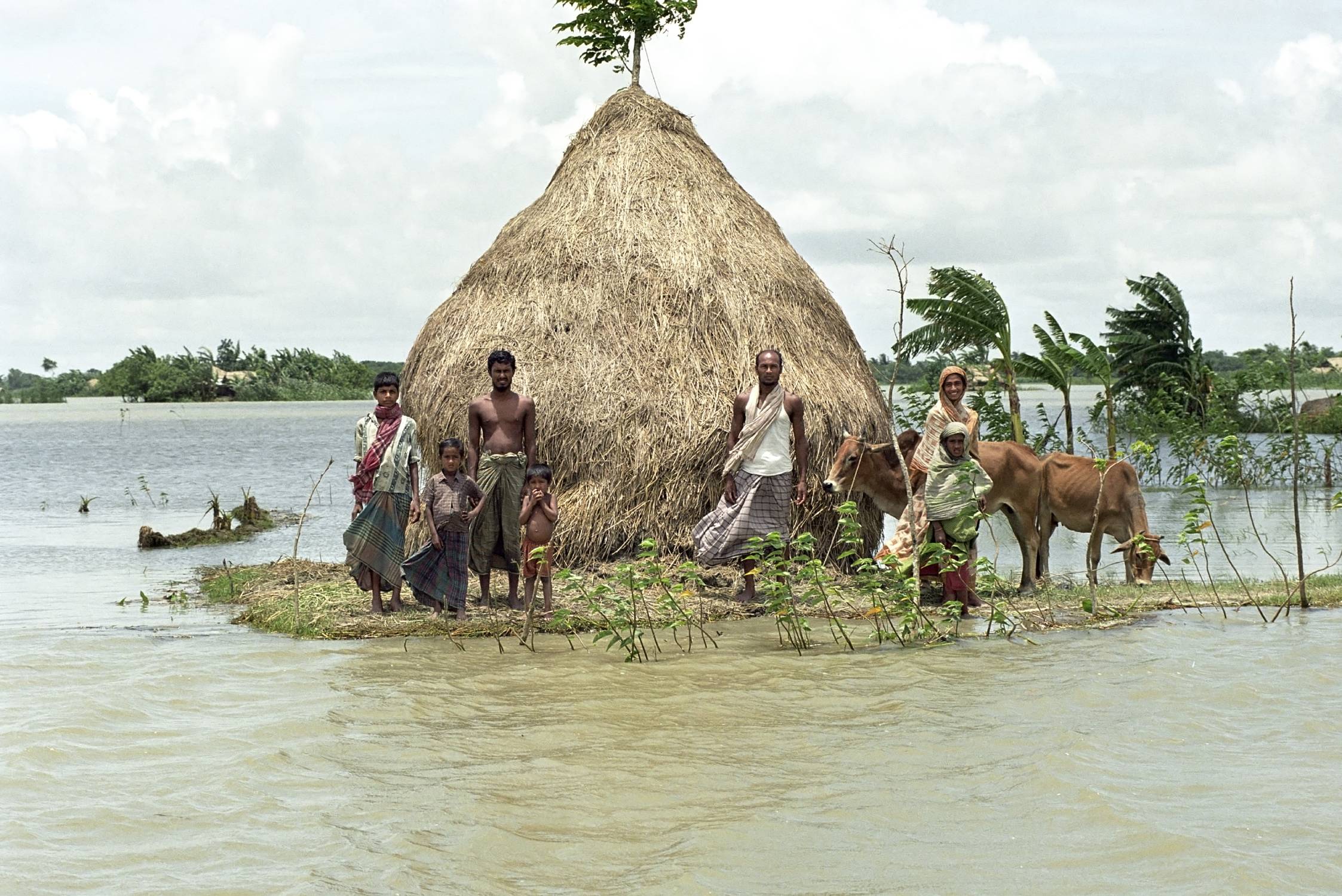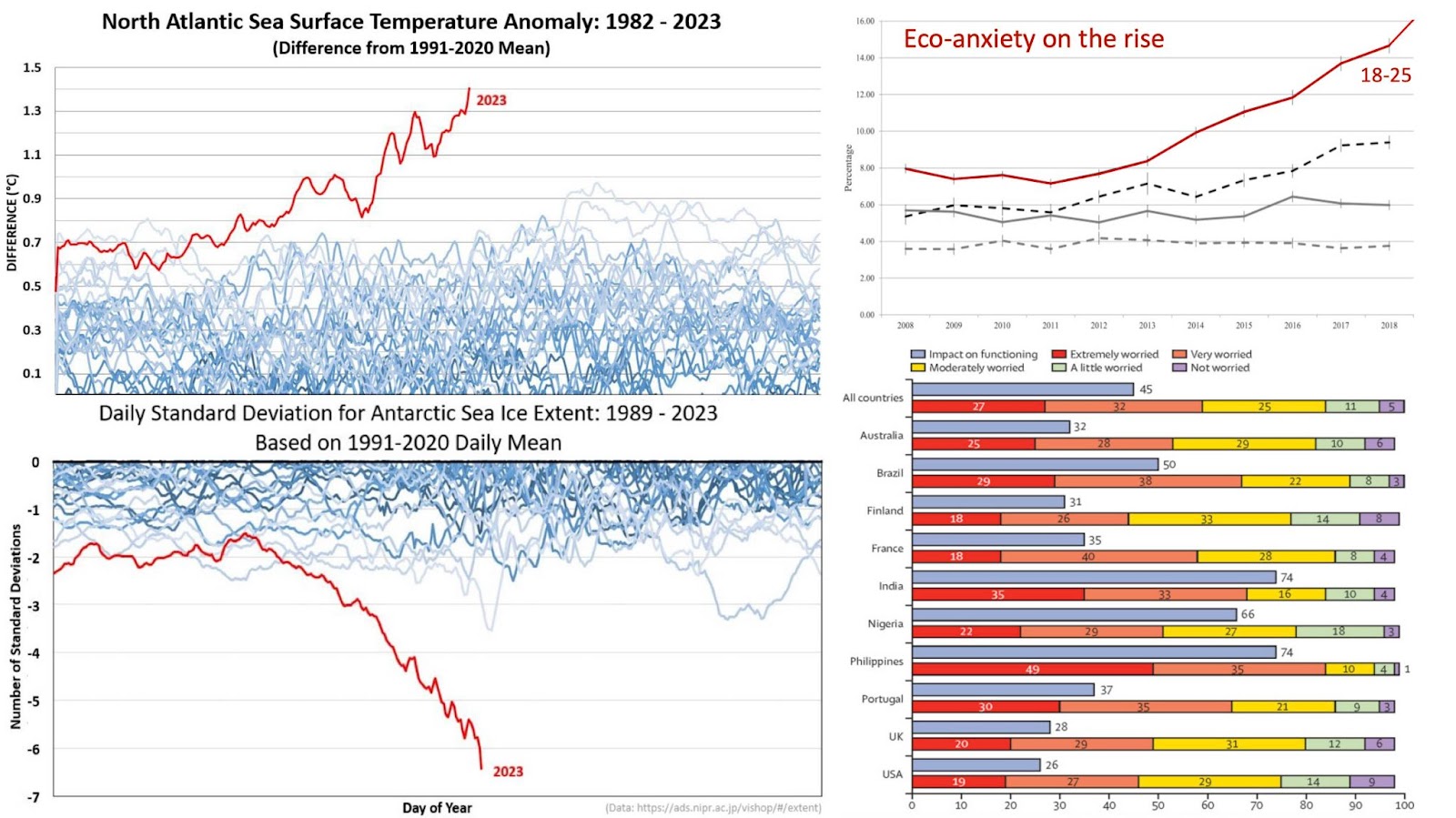Why climate change is a public health issue
Climate change poses significant threats to public health around the world. Rising temperatures, extreme weather events, poor air quality, and other impacts of climate change directly harm human health.
Furthermore, climate change exacerbates existing health inequalities between wealthier and poorer communities and can contribute to new health risks, including the outbreak of novel diseases like COVID-19.
Even more, the steady drumbeat of troubling information about climate impacts, which some call climate doomerism, is creating a mental health epidemic, especially among young people.
We’ll dive into these three main types of health impacts and discuss why we need to start treating the climate crisis like a public health crisis.

Smog covers London skyline at sunset. Photo 68992684 © Michael Sheridan _ Dreamstime.com
Physical health impacts
Some of the most direct effects of climate change on physical health stem from higher temperatures, pollution, and extreme weather events.
A recent comprehensive study in BMC Public Health found that the impacts of climate change on public health are far-reaching, affecting everything from the spread of infectious diseases to the exacerbation of air quality issues.
Heat-related illness
Higher temperatures and more frequent, intense heat waves lead to heat-related illnesses such as heat stroke, exhaustion, cramps, and rashes. These conditions can be severe or even fatal. Infants, young children, older adults, outdoor workers, and people with existing medical conditions are especially vulnerable to heat effects. But heat waves can harm anyone by pushing the body beyond its limits for temperature regulation. As climate change accelerates, heat-related hospitalizations and deaths are projected to increase.
Deteriorating air quality
Climate change worsens air quality by increasing ground-level ozone (a component of smog), pollen, and wildfire smoke. This leads to respiratory and cardiovascular problems, including asthma attacks, chronic obstructive pulmonary disease (COPD) exacerbations, heart attacks, strokes, and premature death.
Air pollution disproportionately affects marginalized populations who are more likely to live near sources of pollution. Children are notably more vulnerable to air pollution's harmful health effects.
The World Health Organization has found that the combined effects of ambient air pollution and household air pollution are associated with 6.7 million premature deaths per year.
Injuries and fatalities from extreme weather
Extreme weather events amplified by climate change, such as hurricanes, floods, and wildfires, directly threaten health through drowning, trauma, burns, smoke inhalation, displacement of populations, and damage to healthcare infrastructure.
The science is clear—climate change is increasing the frequency and severity of extreme weather. This elevates risks to life and health when these disasters occur.
Infectious diseases
Climate change is expected to alter the geographic range, seasonality, and spread of many infectious diseases. Warming temperatures allow disease-carrying mosquitoes, ticks, and other vectors to thrive in new regions.
Changing precipitation patterns can increase the spread of water-borne illnesses. Severe weather events and disrupted ecosystems can spur outbreaks as populations are displaced and pathogens proliferate.
Climate change has expanded the reach of vector-borne diseases like Lyme, West Nile, and Zika. In the future, continued warming could increase the burden of malaria, dengue fever, chikungunya, and other illnesses.
Food and water insecurity
Climate change threatens crop yields, animal populations, and access to safe drinking water. This increases risks for malnutrition and food- and water-borne infections. Droughts, floods, and changes in seasonal weather patterns make it harder for communities to reliably produce and access sufficient nutritious food and clean water.
This issue disproportionately impacts poorer populations already struggling with hunger and inadequate sanitation. Food and water insecurity due to climate change can impair physical health and affect mental health.

Flooding in Bangladesh, village Charburhan on the island of Charkajal, Bay, Gulf of Bengal.. Photo ID 62637093 © Sjors737 | Dreamstime.com
Unequal health impacts
The health effects of climate change disproportionately affect marginalized groups with fewer resources to mitigate risks or recover from impacts.
- Low-income communities tend to face more exposure to extreme heat, flooding, and pollution. They may lack access to air conditioning, quality healthcare, or insurance to rebuild after disasters.
- Communities of color are disproportionately exposed to toxic air pollution from the fossil fuel industry. Data also shows a higher incidence of asthma, heart disease, and premature death in areas with more environmental pollution.
- Elderly, young, pregnant, and disabled individuals have physiological vulnerabilities that amplify climate health risks.
- Outdoor workers have greater exposure to heat, air pollution, vectors, and extreme weather that endangers health. Many outdoor workers are from socioeconomically disadvantaged communities.
- Indigenous populations and rural communities often directly depend on threatened natural resources and ecosystems for survival and culture. Climate impacts on fisheries, agricultural land, and water access undermine health.
- Mental, physical, and chemical dependence can impede an individual's ability to protect themselves from climate threats. Homeless populations are especially vulnerable to a warming climate.
Climate change also contributes to displacement and forced migration through impacts like desertification, rising sea levels, erosion, droughts, and extreme weather. Sudden or gradual environmental changes can make homelands uninhabitable. By 2050, over 200 million people may be displaced by climate impacts.
Population displacement creates crowded conditions conducive to disease transmission. It also harms mental health through trauma, loss of home, and loss of social networks and identity. Environmental migrants often face discrimination and barriers to healthcare access as well.
Climate change also indirectly affects well-being by exacerbating health disparities and stress. Despite contributing the least to carbon emissions, marginalized groups worldwide face an unjust climate burden. Climate change amplifies existing health disparities and creates new health equity issues as risks intensify.
In these ways, the environmental shifts caused by climate change directly threaten human health via higher temperatures, degraded air and water, extreme weather, shifting disease patterns, food insecurity, and displacement of populations.
Public health organizations should work to identify populations vulnerable to climate impacts and then allocate resources accordingly to help increase resilience and adaptive capacity where it's needed most.
Mental health impacts

The increases in climate impacts, for example, the dramatic spike in ocean temperatures (top left) or the collapse of polar ice (lower left), coincide with a rise in reported eco-anxiety symptoms, especially amongst younger people (top right). A recent study found that in countries hardest hit by climate change, like the Philippines and India, as much as three-quarters of young people feel somewhat incapacitated by climate anxiety. Even in Global North countries like the US and UK, more than one-quarter of young people feel incapacitated.
Climate change doesn't just harm physical health—it also extracts a toll on mental health. The psychological responses to climate impacts include:
Eco-anxiety and grief
Witnessing ecological destruction and loss firsthand (or through media) can cause clinically significant anxiety, depression, PTSD, and adjustment disorders. Young people report high rates of eco-anxiety over the fear of inheriting a damaged planet.
Existential distress over the loss of biodiversity, natural landscapes, and the climate stability humans depend on can manifest as grief responses. Mental health professionals are developing diagnoses and counseling approaches for eco-anxiety and solastalgia, or "homesickness when still at home."
Increased stress, aggression, and violence
Heat, air pollution, and disaster-related losses can increase aggression and interpersonal violence. Studies link high temperatures to spikes in violent crime and suicide rates. Displacement, resource scarcity, and loss of home and social networks also act as climate-related stressors with psychological impacts.
Hopelessness, helplessness, and nihilism
As climate impacts worsen and global action stalls, some people experience a weakened sense of self-efficacy, agency, and purpose. This sense of futility can develop into despair, depression, inaction, and detachment.
Young generations express significant pessimism that society will avoid devastating climate scenarios. When health organizations discuss collapse as inevitable, this can inadvertently reinforce notions of helplessness.
Trauma and PTSD
Extreme weather disasters and oppressive environmental conditions expose many people to traumatic events and surroundings. Loss of loved ones, property, community, identity, and security through climate events (like fires, floods, and heat waves) profoundly damages mental health. Children are especially vulnerable to the long-term effects of climate trauma.
Loss of place, identity, and culture
For Indigenous and local cultures intrinsically tied to ancestral lands and ecosystems, climate-caused losses represent profound threats to communities, traditions, spirituality, subsistence, and ways of life. Loss of place-based identity and culture has extensive intergenerational impacts.
Cognitive impairment, dementia
High urban temperatures are associated with reduced cognitive performance, memory issues, and poor decision-making. Sustained exposure to extreme heat causes lasting neurological changes that impair cognition. Air pollution can also harm brain health across the lifespan and increase dementia risks. Children face learning challenges from exposure to climate health hazards.
In these ways, climate change—while often perceived as a purely environmental issue—significantly harms psychological health at both individual and collective levels. From anxiety and trauma to nihilism and aggression, climate impacts jeopardize the social cohesion and stability required for healthy communities.
Public health organizations have an essential role to play in identifying populations vulnerable to mental health declines, raising awareness of climate psychology concerns, increasing access to counseling and community programs, and advocating for interventions that foster resilience. Strengthening collective psychological adaptation is as important as infrastructure improvements for protecting community mental health from climate risks.
Why a public health approach is critical
Climate change presents risks at a scale that demands strategic, coordinated prevention and response measures. No single individual, community, or nation can entirely mitigate or adapt to all the health impacts we collectively face as greenhouse gas emissions continue rising. That's why climate change demands engagement from the public health sector.
Some of the reasons public health leadership is vital include:
- Public health organizations have expertise in managing health crises and environmental hazards and building community resilience. Climate change will test these capacities on an unprecedented scale.
- Government public health agencies have policy and regulatory tools to drive emission reductions, climate adaptation, and health equity action.
- Public health professionals can coordinate cross-sector collaborations (with groups like energy, transportation, and urban planning) needed for climate intervention and preparedness.
- Leveraging public health systems and infrastructure is crucial for scaling research, tracking health data, conducting surveillance, and evaluating interventions over time.
- Public health agencies must lead high-risk groups in emergency preparedness and ensure the continuity of medical services when climate disasters strike.
- Health organizations have standing in local communities that grants access, trust, and the ability to raise awareness and spur grassroots action.
- Public health outreach and education are indispensable for promoting behaviors and policies that improve climate resilience.
No other entity bears the societal mandate to protect and promote public health as greenhouse gas emissions drive environmental shifts that broadly threaten wellbeing. That's why public health experts argue that climate change should be framed as a health crisis, not just an ecological crisis.
Viewing climate change through a health lens helps convey the urgent need for action and the duty of health organizations to intervene and advocate to avoid preventable harm.
Some recommended public health actions to address climate change include:
- Conducting vulnerability assessments and expanding monitoring of climate health indicators.
- Improving access to medical care, mental health support, and public health resources.
- Targeting preparedness measures toward high-risk populations.
- Educating health professionals and communities on climate health risks.
- Developing health systems' capacity to manage increases in climate-related illness.
- Reducing greenhouse gas and co-pollutant emissions from the healthcare sector.
- Adopting sustainable practices that increase the climate resilience of health facilities.
- Declaring climate change a public health emergency and issuing guidance to local health departments.
- Calling for comprehensive policies to immediately curb greenhouse gas emissions
- Advocating for climate adaptation and systems changes that protect public health.
Climate change is no longer a distant threat but a clear and present danger to public health. Heat waves, wildfires, extreme weather, new disease vectors, mental distress, and environmental degradation endanger our communities here and now while compounding inequities.
Public health organizations must speak up and take meaningful action that curbs climate risks, saves lives immediately, and promotes a more sustainable and socially just future.
That collective action starts with each of us.
.jpg?auto=compress%2Cformat&w=1440)



